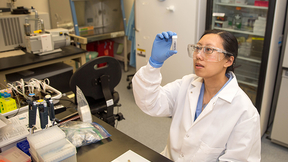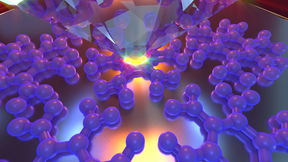Back
Few people over the course of history have had a hand in discovering an atomic element. Yet nuclear chemist Dawn Shaughnessy joined a team of scientists from Lawrence Livermore National Laboratory (LLNL) and Russia that discovered five elements from 1989 to 2010. Now she leads the Nuclear and Radiochemistry Group of the Physics and Life Sciences Directorate at LLNL and…
Comets screaming through the atmosphere of early Earth at tens of thousands of miles per hour likely contained measurable amounts of protein-forming amino acids. Upon impact, these amino acids self-assembled into significantly larger nitrogen-containing aromatic structures that are likely constituents of polymeric biomaterials. That is the conclusion of a new study by…
In 3D printing, residual stress can build up in parts during the printing process due to the expansion of heated material and contraction of cold material, generating forces that can distort the part and cause cracks that can weaken or tear a part to pieces, especially in metals. Researchers at Lawrence Livermore National Laboratory (LLNL) and the University of California,…
For soil microorganisms, how much of their life’s work is driven by evolution (nature) versus their current environmental (nurture)? As it turns out, the evolutionary history of soil microorganisms plays a larger role in growth rates and carbon uptake, according to a new study appearing in the June 17 edition of the journal Nature Ecology & Evolution. "Our results…
Lawrence Livermore National Laboratory (LLNL) climate scientist Benjamin Santer is among scientists, authors, actors, business leaders, lawyers, surgeons and philanthropists who will be heading to the University of East Anglia (UEA) to become honorary graduates next month. "Lord of the Rings" and "Titanic" actor Bernard Hill, "Apple Tree Yard" author Louise Doughty and…
Any single hair from anywhere on the human body can be used to identify a person. This conclusion is one of the key findings from a nearly year-long study by a team of researchers from Lawrence Livermore National Laboratory’s (LLNL) Forensic Science Center (FSC) and Michigan State University. The team’s study, published in Scientific Reports, a journal of Nature Magazine,…
Plant cell walls contain a renewable, nearly limitless supply of sugar that can be used in the production of chemicals and biofuels. However, retrieving these sugars isn’t all that easy. Imidazolium ionic liquid (IIL) solvents are one of the best sources for extracting sugars from plants. But the sugars from IIL-treated biomass are inevitably contaminated with residual…
Lawrence Livermore National Laboratory (LLNL) and the Livermore Lab Foundation (LLF) are exploring the establishment of a consortium that would leverage the Lab’s computing capabilities to identify causal factors for amyotrophic lateral sclerosis (ALS), or Lou Gehrig’s disease. Under a newly signed strategic partnership project agreement, the foundation will provide funds…
Phase-change materials that are used in the latest generation of smartphones could lead to higher storage capability and more energy efficiency. Data is recorded by switching between glassy and crystalline material states by applying a heat pulse. However, to date it has not been possible to study what happens at the atomic level during this process. In a paper published…
Lawrence Livermore National Laboratory (LLNL) climate scientist Benjamin Santer is the recipient of the 2019 Sigma Xi William Procter Prize for Scientific Achievement. The Procter prize has been awarded since 1950 to a scientist who has made an outstanding contribution to scientific research and has demonstrated an ability to communicate the significance of this research…
Gold, silver and copper are heavy metals, but LLNL scientists can now make them nearly as light as air — in a form so tiny it can ride on a mosquito’s back. The groundbreaking science, part of a joint NIF/Physical and Life Sciences (PLS) project supported by the Laboratory Directed Research and Development (LDRD) Program, created these ultra-low density metal foams to give…
Whether you’re busy at work or lounging around at home, indoor air quality probably isn’t anywhere on the list of things on your mind. But numerous studies have shown that the buildup of carbon dioxide in environments such as office buildings, schools and homes can lead to increased health issues and a decrease in productivity, decision-making and cognitive performance. A…
A new generation of ultra-low-density (less than 20 milligrams per cubic centimeter) metal foams for laser targets has been made from metal nanowire suspensions via a unique freeze-casting process. In order to optimize the density, geometry, composition, and mechanical properties of these metal foams, it is necessary to develop nanowire stock materials of highly controlled…
A new publication in the journal Advances in Physics by three Laboratory researchers describes plutonium from first-principles theory. This is the first time a first-principles explanation for the perplexing anomalous negative thermal expansion of the delta phase of plutonium has been reported. Per Söderlind, Alex Landa, and Babak Sadigh (all PHYS) reviewed developments in…
When an electron encounters a laser pulse, it “wiggles” and radiates electromagnetic waves. As simple as this may sound, scientists have long struggled with an unresolved question: is the radiation energy provided by the laser or the electron? At low laser intensity, it has been experimentally confirmed that the radiation energy is entirely provided by the laser, while at…
Multilayer interference mirrors are enabling components in x-ray optical systems. These mirrors consist of periodic or non-periodic structures of alternating thin film layers of two or more materials deposited on an optical substrate. Today’s applications and experimental facilities (including the National Ignition Facility) require novel, multilayer-based hard x-ray…
Soil microbes are wild, unpampered and uncultured. But to understand their ecology, don't look in laboratory cultures, look in the soil. That’s exactly what Lawrence Livermore National Laboratory (LLNL) and Northern Arizona University (NAU) scientists did. Relationships between microbial genes and performance are often evaluated in the lab in pure cultures, with little…
In the nine years since a virtually all-encompassing Lawrence Livermore National Laboratory (LLNL) biological detection system was first introduced, it has become a major hit among technologies. Now called the Applied Biosystems’™ Axiom™ Microbiome Array (ABAMA), the biological detection technology has attracted more than 30 collaborators, has advanced into the marketplace…
Lawrence Livermore National Laboratory (LLNL) scientists in collaboration with University of Nevada Las Vegas (UNLV) have discovered a previously unknown pressure induced phase transition for TATB that can help predict detonation performance and safety of the explosive. The research appears in the May 13 online edition of the Applied Physics Letters and it is highlighted…
Controlling nuclear fusion for power production is expected to require large and expensive magnetic coils or laser systems to create, heat, confine, and control the hot plasma needed to sustain fusion reactions. The idea of directly driving a column of plasma with an electrical discharge, known as Z pinch, was a simple and early method envisioned as a possible path to…
























